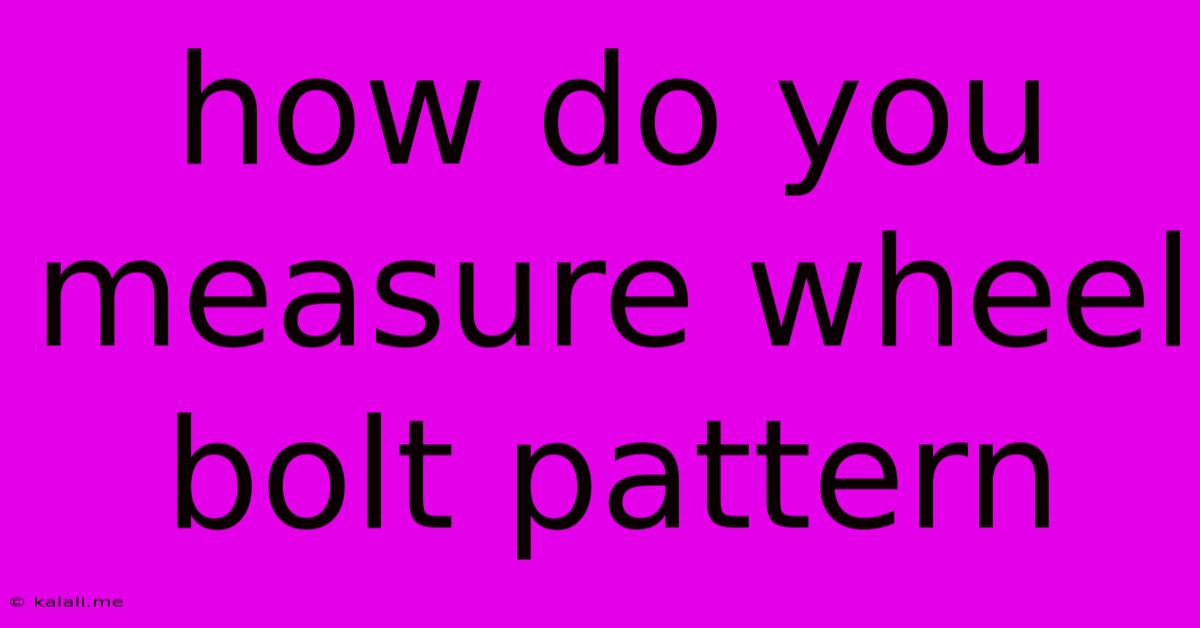How Do You Measure Wheel Bolt Pattern
Kalali
Jun 01, 2025 · 3 min read

Table of Contents
How to Measure Your Wheel Bolt Pattern: A Comprehensive Guide
Knowing your wheel bolt pattern is crucial when buying new wheels for your car. Getting it wrong can be dangerous and costly. This guide will walk you through precisely how to measure your wheel bolt pattern, ensuring a safe and accurate fit. This process involves identifying both the bolt circle diameter (PCD) and the number of lug nuts.
Understanding the Basics: Bolt Pattern Terminology
Before we delve into the measurement process, let's clarify some key terms:
- Bolt Circle Diameter (PCD): This is the diameter of the imaginary circle that passes through the center of each wheel lug bolt hole. It's the most critical measurement for wheel compatibility.
- Number of Lug Nuts (or Studs): This simply refers to the number of bolts or studs that secure the wheel to the hub. Common numbers include 4, 5, and 6.
- Lug Nut Size: While not directly part of the bolt pattern, understanding the size (thread pitch and diameter) of your lug nuts is also essential for purchasing compatible replacements or wheel studs. This information is typically found in your vehicle's owner's manual.
How to Measure Your Wheel Bolt Pattern: A Step-by-Step Guide
-
Safety First: Ensure your vehicle is parked on a level surface and the parking brake is engaged. Use jack stands for added safety if you need to get under the vehicle.
-
Remove a Wheel (Optional): For the most accurate measurement, removing a wheel is ideal. This provides clearer access to the lug bolt holes. If you're uncomfortable removing a wheel, proceed to step 3.
-
Locate the Lug Bolt Holes: Identify the holes where your lug nuts or studs are located.
-
Measure the Distance Between Two Opposite Lug Holes: Using a ruler or calipers, carefully measure the distance between two lug bolt holes that are directly opposite each other. This measurement represents the diameter of the bolt circle.
-
Calculate the Bolt Circle Diameter (PCD): This measurement is actually the diameter, not the radius. You've already measured the diameter so, technically, you are done!
-
Count the Number of Lug Nuts (or Studs): Simply count the number of lug nuts or studs present on your wheel hub. This is typically 4, 5, or 6, but variations exist.
-
Record Your Findings: Write down both the PCD (in millimeters or inches) and the number of lug nuts. This information is typically expressed as "PCD x Number of Lug Nuts" (e.g., 5x114.3mm or 5x4.5").
Alternative Measurement Methods (If Wheel Removal is Not Possible):
If removing a wheel is impractical, you can obtain an approximation of the PCD using a flexible tape measure. Carefully wrap the tape measure around the lug holes, ensuring it follows the circumference of the imaginary circle. Then, divide the measurement by π (approximately 3.14159) to get the diameter. This method is less precise than directly measuring the diameter between opposite holes.
Important Considerations:
- Accuracy: Precise measurement is critical. Slight inaccuracies can lead to wheel fitment problems.
- Vehicle Specifics: Different vehicle models and even trim levels within the same model may have different bolt patterns. Always verify the bolt pattern for your specific vehicle year and model.
- Wheel Compatibility: Once you know your bolt pattern, use this information when searching for new wheels to ensure compatibility.
By following these steps, you'll confidently determine your vehicle's wheel bolt pattern and make informed decisions when purchasing new wheels. Remember safety is paramount, so take your time and proceed cautiously.
Latest Posts
Latest Posts
-
How To Know Head Gasket Is Blown
Jun 03, 2025
-
Is A Periodical Title A Magazine Title
Jun 03, 2025
-
Many Are Called But Few Are Chosen Meaning
Jun 03, 2025
-
How To Change Bulb On Recessed Light
Jun 03, 2025
-
Can Stainless Steel Cookware Go In The Oven
Jun 03, 2025
Related Post
Thank you for visiting our website which covers about How Do You Measure Wheel Bolt Pattern . We hope the information provided has been useful to you. Feel free to contact us if you have any questions or need further assistance. See you next time and don't miss to bookmark.